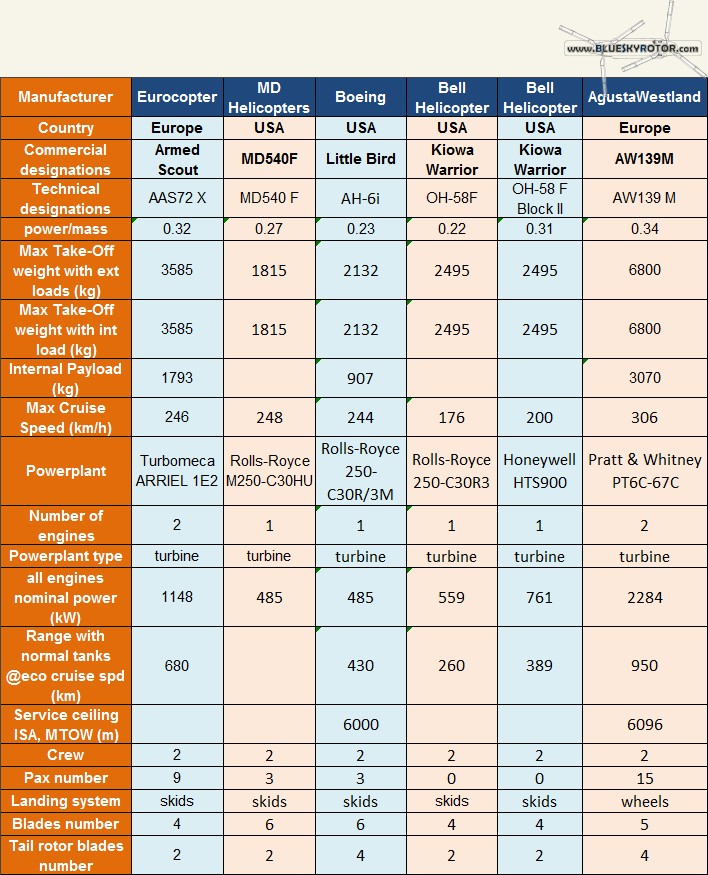

The competition to the definition of a new Armed Scout helicopter is in full swing as Bell Helicopter, Boeing and Eurocopter participated in the voluntary flight demonstration. Considering the great number of participants, I think a performance comparison may be helpful.
Two aircraft are not considered in this article, even if already presented earlier: the AVX, based on a twin propeller redesign of the current Kiowa, and the S-97 Raider of Sikorsky, new concept based on the high-speed X2. Because these aircraft have not been flown yet, no actual performance data are available. Therefore, we cannot consider them in the comparison today.
Technical data
Unfortunately not all values are available for all aircraft, because some of them are still under development and improvement and the manufacturers have not explored the entire flight envelope yet. Nevertheless, we can consider that similar platforms share similar performance, such as a the payload for AH-6i and for MD540F.
Also OH-58D has a useful load of 909 kg and we’ll take it for OH-58F and Block II.
You will notice that Boeing uses the same platform as MD Helicopters, but brought deep modifications. A new tail rotor (similar to AH-64 Apache) or another weapon pylon are the most visible differences, but we will see in a later article that Boeing leads a highly interesting technology development in order to propose a drone option of AH-6i.
Engines number
Twin-engined aircraft must carry the additional weight of the second engine, but the reliability of the system is increased. You are allowed to lose one engine and continue your flight back to base.
Range
The aircraft of MD Helicopters, Boeing and Bell Helicopter offer a relatively low range (from 260 to 430 km, or 232 nautical miles). Eurocopter and AgustaWestland have a much wider range of respectively 680 km and 950 km (513 nautical miles).
Engine power
Engine power alone is not significant, we need to relate it to the gross weight (MTOW). Under this conditon, the great winners are the AW139M, AAS-72X and OH-58F Block II. We see here that the exchange of a newer engine for OH-58F provides a competitive advantage.
Unfortunately, we cannot pull the analysis any further with aerodynamical parameters due to their unavailability. (if you have values like the balde chords or the rotor rotation speeds, send them to us !)
In order to obtain a strictly correct analysis of performance in the aerodynamical point of view, we need to determine the rotor solidity ratio. Unfortunately, geometric data of rotors have not been released for all aircraft yet, but this topic will be the object of a future article when possible.
Max speed
Apparently, Bell’s OH-58 Fs are not the fastest helicopters, even if Vne is not known for now. On the other hand, Eurocopter, MD and Boeing are performing quite well. The helicopter with the top speed is the AW139M providing an impressive 306 km/h (165 kt).
Weight
Payload capability is critical as well as agility. Too light aircraft will not have the capability to perform well in a constraining environment while carrying payload. On the other hand, big aircraft will be limited in their agility.
Therefore AW139M is at risk of being considered too huge for the typical mission of an armed scout. 6800 kg are more than twice as much as the other competitors. Military pilots need easy maneuverability in tight spaces, like narrow streets during urban combat or under high voltage power lines.
In order to make a clean comparison, we need to know the fuel tanks capability as well, which are not provided for every aircraft. Therefore, we will have to remind the fact that lightest aircraft have no possibility to carry both weapons and passengers. It will even not be possible to install a third crew member as door gunner.
Conclusion
Based on the perfomance of the aircraft, the best competitor is the Eurocopter AAS-72x, followed by Bell Helicopter OH-58 F Block II. They provide the best power availability, high agility, sufficient cruise speed and an interesting range.
Against the Kiowa, the best assets of AAS-72X are its increased range and the space available in the cabin, making it able to carry passengers, door gunners or a camera or winch operator.
Nevertheless, the Little Bird is famous for the support it provides to the US forces on many combat theatres and the experience provides positive consideration. A future analysis will consider the drone instead of the manned aircraft.
[edited after constructive comments from Mike Hampson, owner of http://helicopterlinks.com/, October 27th, 2012]

Sorry, the comment form is closed at this time.